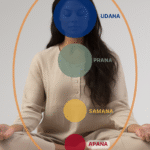The five Vayus in yogic philosophy describe the different ways prana, or life force, moves through the body. While Udana Vayu carries energy upward and Apana Vayu moves it downward, Prana Vayu governs the inward and upward flow. It is the essential intake of energy that sustains life.
What is Prana Vayu?
The word Prana itself means “life force,” and while all Vayus are aspects of prana, Prana Vayu is considered the central and governing force. It is responsible for the intake and assimilation of energy, whether it’s through breath, food, water, sensory experience or thought.
The flow of Prana Vayu moves inward and upward, centered around the chest region. It is intimately connected to the breath and serves as the gateway for life-sustaining functions in both the body and mind.
Key functions
This Vayu plays a foundational role in both physiological and mental processes:
Prana Vayu and the Chakras
Prana Vayu resides between the throat and heart, with its main seat in the Anahata Chakra (Heart Chakra).
Anahata is the center of love, balance and connection, and when Prana Vayu flows freely, we feel emotionally open, mentally clear and physically energised.
A blocked or weakened Prana Vayu can result in low mood, emotional heaviness, or even cardiovascular issues, as the energetic flow to the heart is compromised.
Signs of imbalance
An imbalance in Prana Vayu may show up as:
How to balance Prana Vayu
Because Prana Vayu is so closely linked to breath, awareness and intake, its balance is best supported through practices that cultivate presence, expand breath capacity and encourage inner stillness.
Asana
Choose postures that open the chest and invite breath into the upper body:
Pranayama
Meditation & Mudras
Ayurvedic support
Support Prana Vayu through mindful intake and calm surroundings:
Bringing Prana Vayu awareness into your practice
For many yoga teachers and practitioners, Prana Vayu is the starting point, the breath that sustains the practice, and the awareness that sustains the self. When we attune to this inward-moving energy, we deepen our connection to vitality, presence and intuitive flow.
Refining and balancing Prana Vayu strengthens the foundation of our life force. When breath, energy and emotion move in harmony, the practice becomes more grounded and clear. This sense of balance can gently extend into everyday life and teaching.






